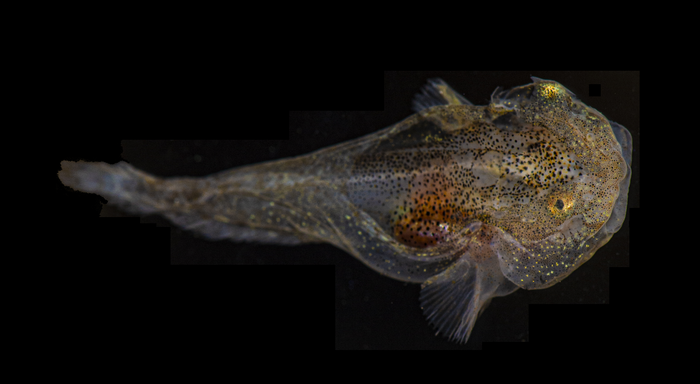New research based on an expedition to the icy waters off Greenland reveals soaring levels of antifreeze proteins in a species of tiny snailfish, underlying the importance of this unique adaptation to life in sub-zero temperatures. The study, led by scientists at the American Museum of Natural History and the City University of New York (CUNY), and published today in the journal Evolutionary Bioinformatics, also warns that warming oceanic temperatures in the Arctic could pose a threat to these highly specialized fishes.

Credit: © J. Sparks, D. Gruber
New research based on an expedition to the icy waters off Greenland reveals soaring levels of antifreeze proteins in a species of tiny snailfish, underlying the importance of this unique adaptation to life in sub-zero temperatures. The study, led by scientists at the American Museum of Natural History and the City University of New York (CUNY), and published today in the journal Evolutionary Bioinformatics, also warns that warming oceanic temperatures in the Arctic could pose a threat to these highly specialized fishes.
“Similar to how antifreeze in your car keeps the water in your radiator from freezing in cold temperatures, some animals have evolved amazing machinery that prevent them from freezing, such as antifreeze proteins, which prevent ice crystals from forming,” said David Gruber, a research associate at the Museum and a distinguished biology professor at CUNY’s Baruch College. “We already knew that this tiny snailfish, which lives in extremely cold waters, produced antifreeze proteins, but we didn’t realize just how chock-full of those proteins it is—and the amount of effort it was putting into making these proteins.”
The icy waters of polar oceans are an extreme environment for marine life, limiting inhabitants to those with mechanisms to cope with freezing temperatures. Unlike some species of reptiles and insects, fishes cannot survive even partial freezing of their body fluids, so they depend on antifreeze proteins, made primarily in the liver, to prevent the formation of large ice grains inside their cells and body fluids. The ability of fishes to make these specialized proteins was discovered nearly 50 years ago, and scientists have since determined that antifreeze proteins are made from five different gene families.
Gruber and co-author John Sparks, a curator in the Museum’s Department of Ichthyology, decided to investigate the antifreeze proteins of the juvenile variegated snailfish, Liparis gibbus, after encountering a separate exceptional ability of the tiny fish—biofluorescence. In 2019, as part of a Constantine. S. Niarchos Expedition, Sparks and Gruber were exploring the iceberg habitats off the coast of Eastern Greenland when they found a juvenile variegated snailfish glowing in green and red. Biofluorescence, the ability to convert blue light into green, red, or yellow light, is rare among Arctic fishes—where there are prolonged periods of darkness—and the snailfish remains the only polar fish reported to biofluoresce.
Upon further investigation of the biofluorescent properties of snailfish, the researchers found two different types of gene families encoding for antifreeze proteins. The snailfish genes have the highest expression levels of antifreeze proteins ever observed, highlighting their importance to these animals’ survival and sending up a red flag about how they might fare in warming environmental conditions.
“Since the mid-20th century, temperatures have increased twice as fast in the Arctic as in mid-latitudes and some studies predict that if Arctic sea ice decline continues at this current rate, in the summer the Arctic Ocean will be mostly ice-free within the next three decades,” Sparks said. “Arctic seas do not support a high diversity of fish species, and our study hypothesizes that with increasingly warming oceanic temperatures, ice-dwelling specialists such as this snailfish may encounter increased competition by more temperate species that were previously unable to survive at these higher northern latitudes.”
Other authors on this study include John Burns, American Museum of Natural History and the Bigelow Laboratory for Ocean Sciences; Jean Gaffney, CUNY; and Mercer Brugler, American Museum of Natural History and the University of South Carolina Beaufort.
This research was generously supported by the Stavros Niarchos Foundation through an AMNH Constantine S. Niarchos Expedition grant.
A video about the 2019 Constantine S. Niarchos Expedition that resulted in these findings can be viewed here.
ABOUT THE AMERICAN MUSEUM OF NATURAL HISTORY (AMNH)
The American Museum of Natural History, founded in 1869, is one of the world’s preeminent scientific, educational, and cultural institutions. The Museum encompasses more than 40 permanent exhibition halls, including those in the Rose Center for Earth and Space plus the Hayden Planetarium, as well as galleries for temporary exhibitions. The Museum’s scientists draw on a world-class research collection of more than 34 million artifacts and specimens, some of which are billions of years old, and on one of the largest natural history libraries in the world. Through its Richard Gilder Graduate School, the Museum grants the Ph.D. degree in Comparative Biology and the Master of Arts in Teaching (MAT) degree, the only such free-standing, degree-granting programs at any museum in the United States. The Museum’s website, digital videos, and apps for mobile devices bring its collections, exhibitions, and educational programs to millions more around the world. Visit amnh.org for more information.
Journal
Evolutionary Bioinformatics
DOI
10.1177/11769343221118347
Method of Research
Observational study
Subject of Research
Animals
Article Title
Transcriptomics of a Greenlandic Snailfish Reveals Exceptionally High Expression of Antifreeze Protein Transcripts
Article Publication Date
16-Aug-2022




